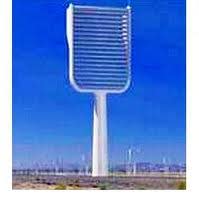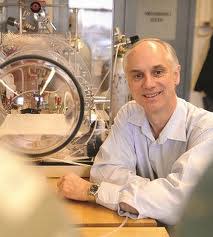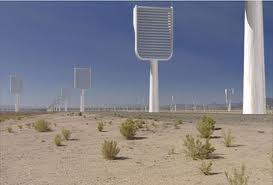Can Synthetic Trees Be a Substitute for Real Ones in CO2 Absorption ?
The Earth's temperature is rising. We can argue about whether it is a short-term or long-term trend, or whether it is natural variation or man-induced, but it is warming. But now it's our duty to pay something to cure our mother earth. A normal person helps it by just planting a tree because trees absorb Co2.
But is there something we can do to absorb CO2 beyond trees.
The idea of forming synthetic tress has been worked on for some time by by Dr Klaus Lackner, of Columbia University.it is hoped that these "synthetic trees" will be able to collect and trap carbon about 1000 times faster than the real thing.
Basically as the wind blows though plastic "leaves," the carbon is trapped in a chamber,compressed and stored as liquid carbon dioxide.
The technology is similar to that used to capture carbon from flue stacks at coal-fired power plants, but the difference is that the "synthetic tree" can catch carbon at any place and at any time . As Professor Klaus Lackner, Ewing-Worzel Professor of Geophysics in the Department of Earth and Environmental Engineering at Columbia University says""Half of your emissions come from small, distributed sources where collection at the site is either impossible or impractical,
The design of synthetic trees looks like a large box with filters like straws through which the air travels. So if the air coming into the box has 400 parts per million (ppm) of CO2, the air coming out will have maybe 300ppm or even 200ppm. They are not trying to remove all the CO2 becausetheir goal is to collect CO2, not to make CO2-free air.
These "trees" were being experimentally planted at the start of 2010 in the prototype stage by professor and inventor Klaus Lackner, in the United Kingdom
One of these "trees" can absorb up to ten tons of carbon dioxide a day, a thousand times more than a single live tree. Each tree would apparently cost around $24,000 dollars and forests of hundreds of them are being planned, to attempt to reduce the United Kingdom's carbon dioxide emissions by 60%. Sodium hydroxide is used in this process to convert carbon dioxide to sodium carbonate.
The captured carbon dioxide further might be use in small markets which need CO2 to run businesses, for example dry ice producers, greenhouses, algae ponds and enhanced oil recovery.
The study also calls for pots of algae that absorb CO2 from the atmosphere to be used
to line buildings. The algae could then be processed into bio fuels for cars. The scientists argue that a single synthetic tree, which would be two-thirds as tall as a wind turbine, could capture ten tons of carbon dioxide from the air every day, making it thousands of times more efficient at absorbing CO2 than a real tree.
The trees would be coated with synthetic materials that absorb CO2, which would then be removed and stored underground in depleted oil and natural gas reservoirs. And that seems to be the risky bit as the work on carbon sequestration and its safety seems to be anything but complete.



